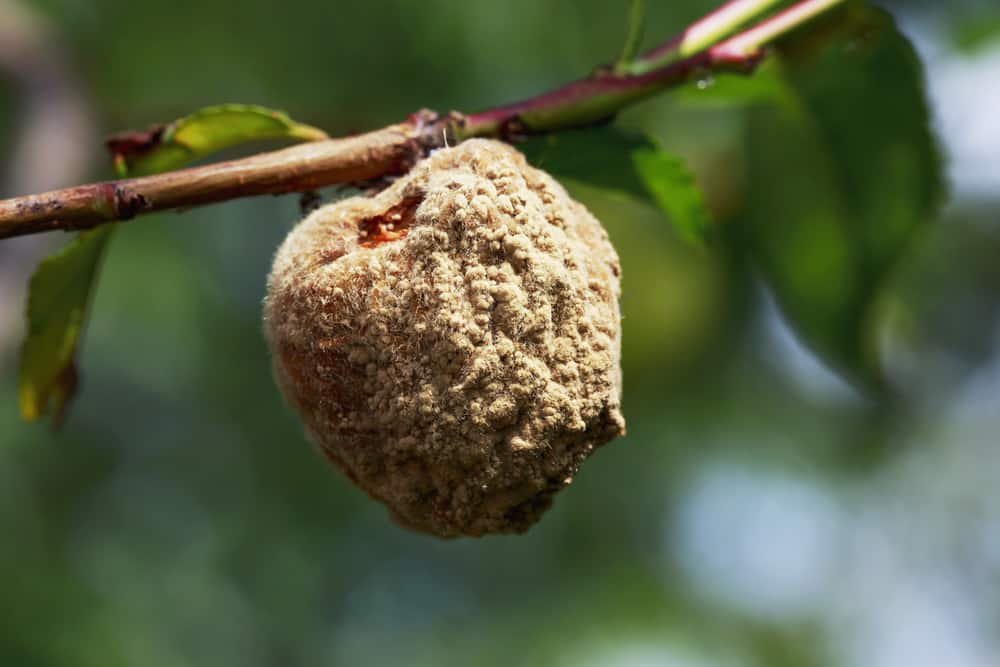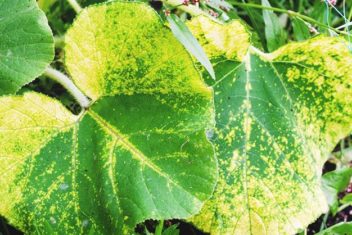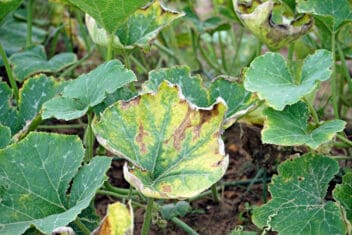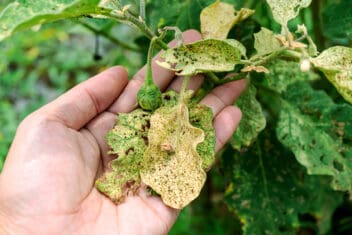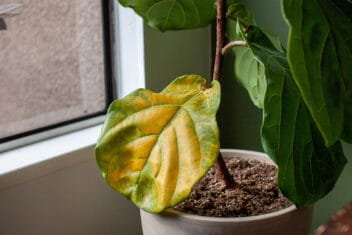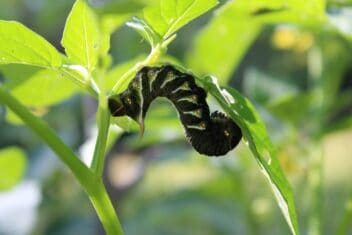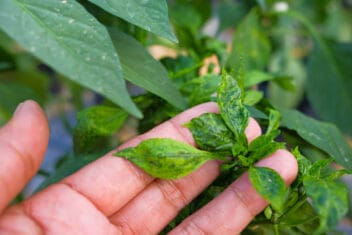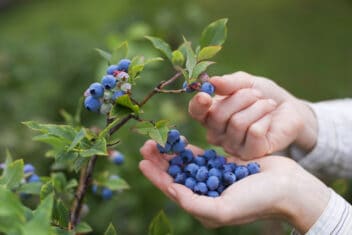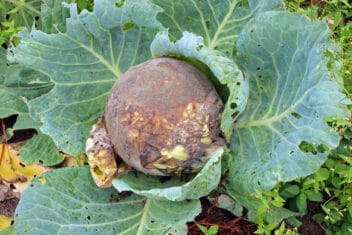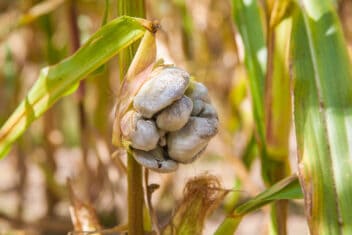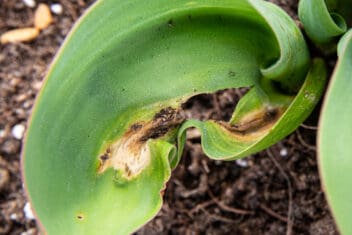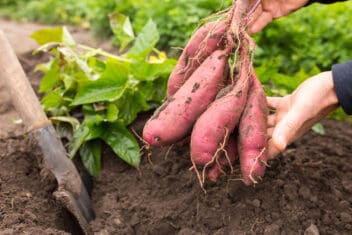Who doesn’t love peaches? Their appearance signal the season when we reap the rewards of all our work in the garden and orchard. Just thinking about a sun-warmed, juicy peach is enough to make your mouth water.
That is why it can be heartbreaking when your beloved fruits are attacked by the many peach pests and diseases who also love them.
Peaches are pretty delicate, which sometimes means the fruit and tree have a hard time once infected or have pest problems.
If you love growing peaches, let’s look at what you may face.
Peach Diseases
Diseases are typically less common than pests, but they can be much more devastating when they’re around. We’ll get to peach pests in a minute, but first, here are some of the most devastating peach diseases:
1. Brown Rot
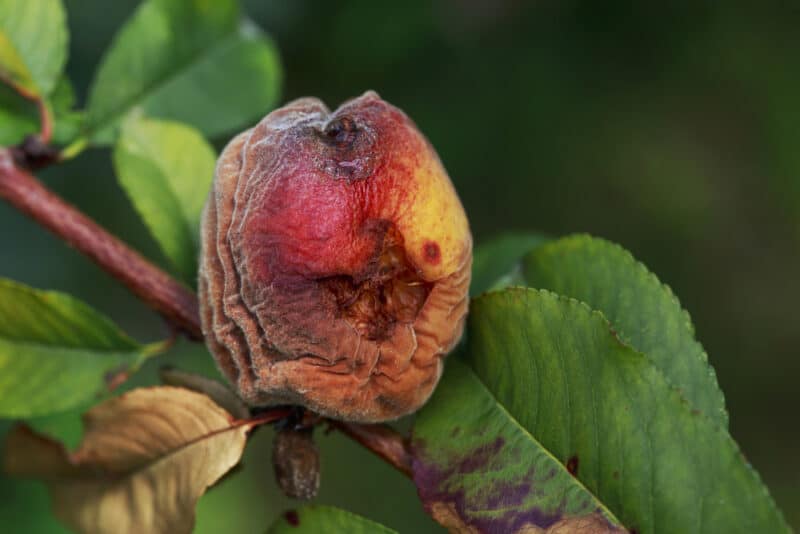
Brown rot (Monilinia fructicola formerly Sclerotonia fruticola) is a common fungal condition in peaches and other stone fruit. Your peach tree may have brown rot if you’ve seen dried-up, mummified fruit attached to the branch or on the ground.
The fungus enters the fruit through damage caused by insects, bruising, or garden tools. It’s common in warm, humid environments and needs several hours of rainfall to spread.
When infected, the fruit rots and mummifies. During this time, the spores are spread by wind and rain and will continue to spread from the mummified fruit where the fungus overwinters.
You will notice small spores or marks on the fruit. These expand quickly, and the fruit rots.
Parts of the tree will also have cankers.
Treating brown rot involves removing rotting or mummified fruit on the ground or still on the tree. Don’t place these in the compost. Prune off any cankerous parts of the tree during the winter. Thin the fruits so they don’t touch, which encourages rot.
Some fungicides are useful, but you have to make sure it is brown rot, not something else the fungicide won’t work on. Brown rot is one of the most common peach diseases, so chances are pretty high that this is what you’re dealing with if you see the symptoms.
If you have had brown rot in stone fruit in the past, use a fungicide as a matter of course after petal fall and every two weeks until harvest. The worst times for brown rot are at the blossom stage and about four weeks before harvest.
A fungicide that contains thiophanate methyl is effective at preventing the disease. There are no fungicides that will eliminate once it’s present.
A product like Regalia can be added to your spray routine. It’s not a fungicide, but it supports the tree to better withstand disease.
2. Fungal Gummosis
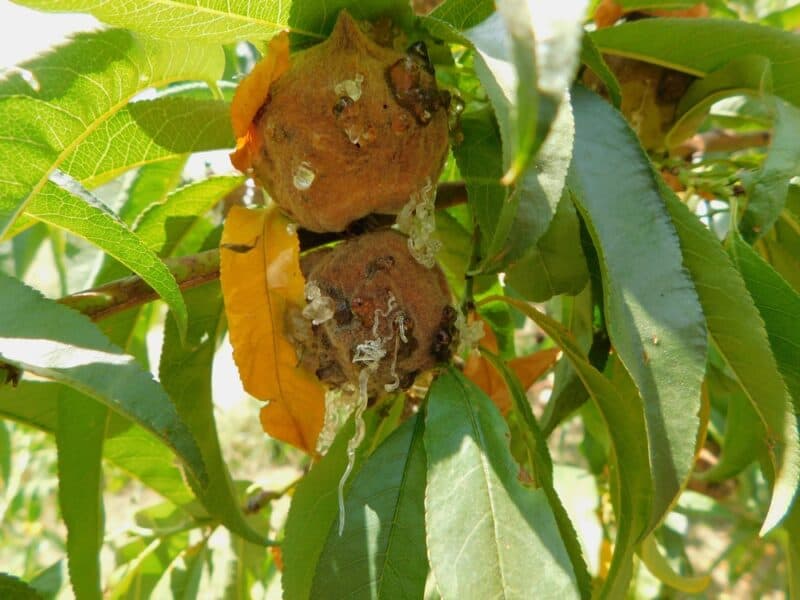
Botryosphaeria dothidea is a fungal pathogen that causes a gum-like sap to ooze from your tree. It’s a sign that something is wrong with the tree, and this is the response to the infection.
Gum-like sap can also be a sign of peach pests, so be sure you know what you’re dealing with before you start treatment.
The fungus enters the tree through injuries. It overwinters in the infected tree and in debris on the ground. It’s spread by wind, rain, and irrigation splashes, and can reduce the yield and quality of the tree by more than 40%.
The first thing you will see is tiny blisters, especially near wounds. As these blisters grow, the tree releases gum as a defense mechanism. Heavy rain and high humidity make it more likely to occur. The disease overwinters on the tree.
If you see this on your peach tree, be wary of it spreading to apricots, almonds, or plums.
Treating fungal gummosis is hard because fungicides generally don’t work. Orchard hygiene is critical. Be careful not to wound the tree, clean all pruning and cutting tools, and clear away weeds and orchard debris.
Prune away dead and diseased wood as they harbor the disease, but don’t prune directly after rain. If you note any gummy deposits on trees in the orchard, prune those areas last, ensuring you don’t transfer any disease to healthy trees.
Ensure good airflow in the orchard, minimize pest damage, and avoid the tree becoming stressed by insufficient water or nutrients, especially when it’s warm.
3. Cytospora Canker
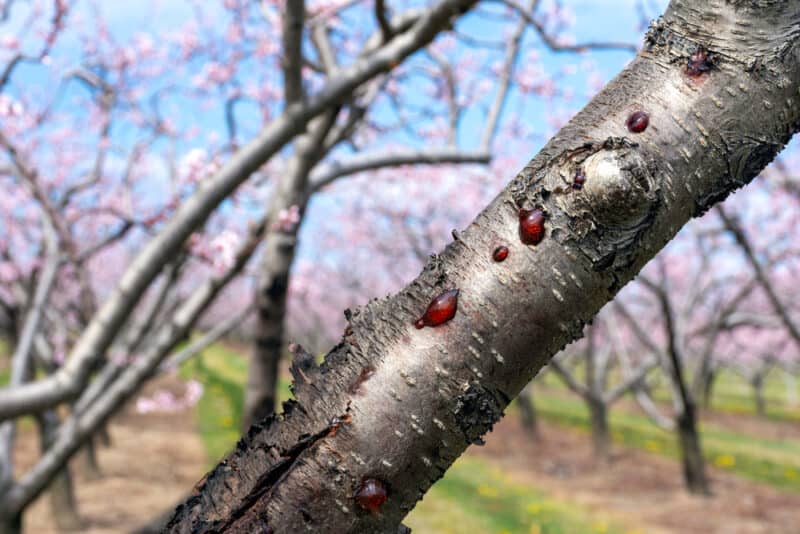
Cytospora canker (Cytospora spp.) is a common disease in many parts of North America, and all stone fruits are susceptible.
This is a weak pathogen and generally only infects weakened or stressed trees. It enters through wounds in the bark. A canker forms over the growing season, or more slowly, over several years. It may girdle the tree causing it to weaken further.
When temperatures are around 60-80ºF in spring, the disease is prevalent. Look for:
- Sunken brown or gray cankers on branches.
- Pimples in the bark with black fungus-like material in them.
- Orange to dark brown masses on the bark or in wounds.
Prevention is key because there are no chemical controls that affect this disease.
- Maintain tree health by sufficient water and nutrients.
- Fertilize in spring when nutrient demands are at their highest.
- Don’t provide high levels of nitrogen in late summer. This causes a flush of growth in fall that doesn’t harden off before winter.
- Prune out dead or diseased branches. Keep the pruning cuts small by pruning regularly.
- Control insects that cause damage, especially wood-boring pests.
4. Coryneum Blight
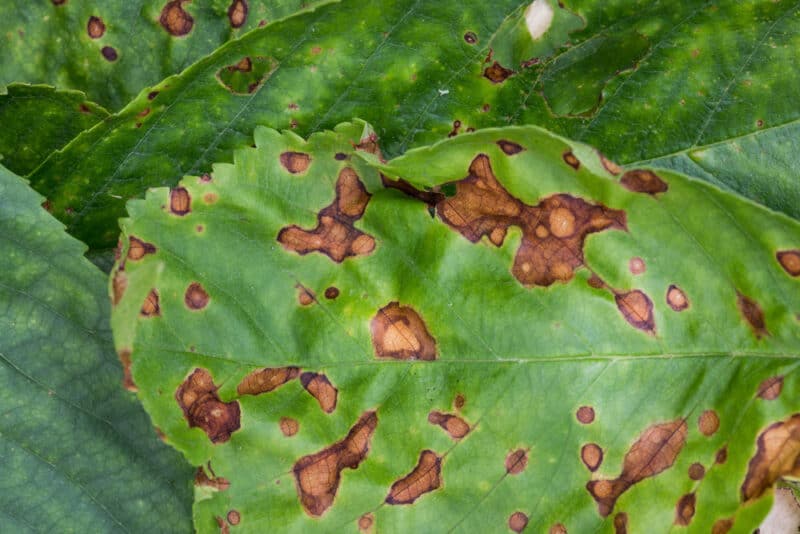
Also known as shothole blight, this disease affects peaches and other stone fruit.
The fungus Stigmina carpophila (formerly Wilsonomyces acidophilus) infects twigs, branches, buds, leaves, blossoms, and fruit.
It appears in cool and wet spring seasons, although extended periods of wet at any time of the year is also a time of concern. The disease overwinters in diseased buds and twigs. It is spread by wind and rain in early spring. The spores can wait in a dormant state for months before the perfect conditions appear.
The symptoms of this disease include:
- Holes in the leaves, hence the name shothole.
- Buds that are much darker than normal or other buds.
- Purple spots on fruit. These may change to white or dirty gray as they get more embedded.
- Small tan lesions on leaves that stay about a quarter of an inch in size.
Treatment for coryneum blight is:
- Remove any infected twigs and destroy them.
- If this disease is common in your area, prune only in the dormant season.
- Apply fungicide in early spring. Ask what is available in your area suitable for coryneum blight.
5. Rusty Spot
This is usually only a pest of peaches, but if you’re unlucky, it may also infect nectarine trees. Peach trees are most at risk.
It’s rusty in name and rusty in appearance. The spots appear on the fruit only. A small rusty lesion will start on the skin of the fruit and grow to the point it covers the whole thing.
Sometimes the fruit will crack due to the infection.
You will see the rusty spots in late spring when you think your peaches are about to be ready soon.
Bordeaux or copper fungicide sprays usually control this disease if you use them as a preventative. Rusty spot is hard to control if it already infects the tree and symptoms are present.
6. Leaf Curl
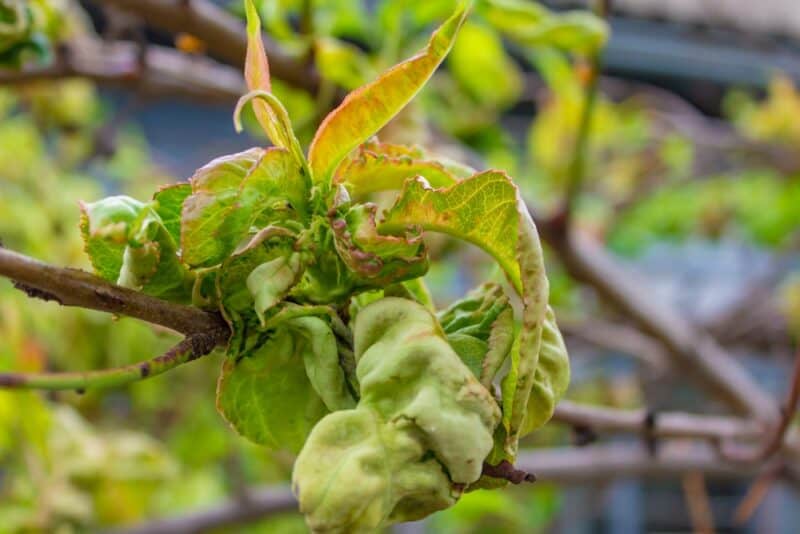
Leaf curl is a persistent fungus (Taphrina deformans). It returns every season once it’s infected a tree.
When leaf curl is present, puckered lesions appear on the leaves. They turn red or tan, then swell and deform the leaf before dropping off. Leaves that grow later that season show no symptoms at all.
The infection can weaken the tree’s vigor and affect fruit yield and quality.
This fungus overwinters on infected debris and fruit. It spreads next spring when it’s below 79ºF and rainy or humid.
The infection of new leaves ceases when the temperatures rise in mid to late spring.
If leaf curl is present, thin the fruit well, avoid drought stress, and ensure the tree has plenty of nutrition. Use a well-balanced fertilizer with nitrogen.
Treatment for leaf curl is:
- You have to wait until leaf drop to prevent leaf curl next season. Once the symptoms appear, there is nothing to do but wait until the end of the season. Apply copper or sulfur fungicide. I alternate both about six weeks apart.
- Remove all damaged and dead branches.
- Remove all debris and fruit from around the tree.
Peach Pests
Peach pests can be anything from a cosmetic bother to a devastating killer. Know what symptoms to look for because catching them early makes all the difference.
1. Peach Twig Borer
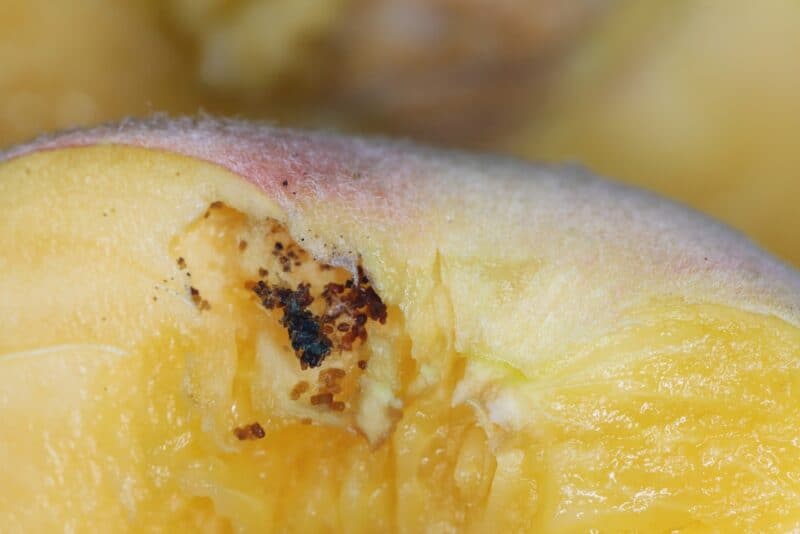
When it comes to peach pests, this is the one to watch for. They’re super common.
Young larvae of the peach twig borer (Anarsia lineatella) appear during bloom and petal fall and bore into new, soft shoots. The first generation overwinters in the cracks and crevices of two- to three-year-old wood.
The second generation bore into the fruit. The adult moths lay yellow or orange eggs placed singly on the undersides of leaves and developing shoots.
You will see dead shoots with wilting leaves. The tree’s growth will be stunted, and the tree will become weak. The worst symptom is an exit hole with a gummy edge in the fruit.
Treatment for peach twig borer is:
- Apply pesticides just before bloom. Ensure you get good coverage because the borer will eat the insecticide when they bore into the new shoots.
- Effective pesticides that aren’t as damaging to the environment include Bacillus thuringiensis and Spinosad.
- Prune the new shoots off that you think may be infected. This stops the life cycle at the larval stage.
2. Prionus or California Root Borer
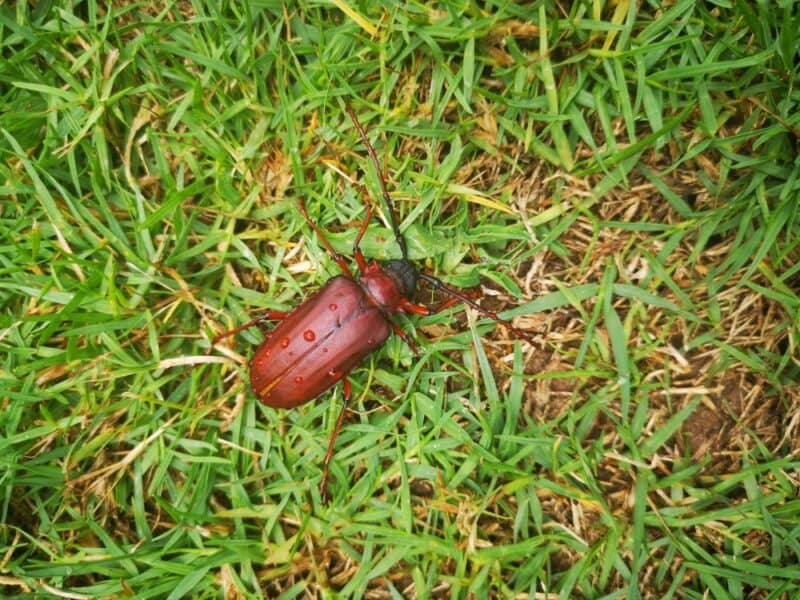
When you discover this pest (Prionus californicus), it may be too late because it has likely been feeding on the roots of peach trees (and other stone fruit) for a couple of years.
The larvae tunnel into the soil and feed on the smaller roots. As it grows bigger, the borer attacks the larger roots and crown of the tree. In about three years, the adult emerges from the soil to mate.
You will see sudden tree decline and canopy death, often after the tree has had low vigor for several seasons.
Of the peach pests you might encounter, this one isn’t common, but it’s nasty when it’s around. It’s native to western North America.
There aren’t any effective treatments for this pest, especially at the larvae stage, since they hide underground. Adults can be killed using a permethrin insecticide.
Ensure the tree doesn’t suffer from stress, especially in sandy soils, which the borer prefers. Supporting your tree and keeping it healthy is important for dealing with many peach pests.
3. Flatheaded Borer
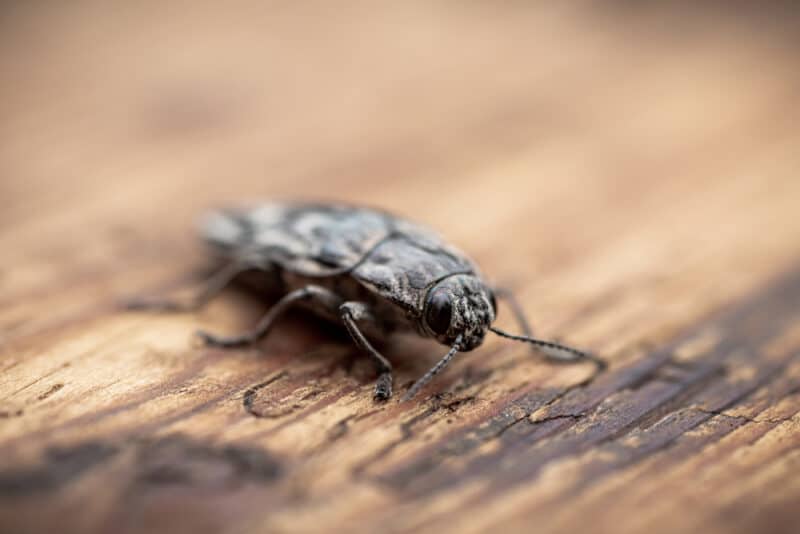
Flathead borers or jewel beetles are peach pests in the Buprestidae family. This pest is usually only an issue on stressed trees. Keeping your peach tree healthy protects against this bug. The larvae feed under the bark, so a stressed tree is quickly overwhelmed.
Look for dead loose bark, oval exit holes, and a general loss of vigor. Sometimes they will kill a tree if they’re in high numbers.
Keep stacks of firewood away from your orchard because they act as a place for the insects to hide. Use a high-quality insecticide in early spring to kill off the adults before they lay eggs.
4. Greater Peach Tree Borer
While they’re not overly common, it’s especially bad for your peach tree if greater peach borer (Synanthedon exitosa) takes hold. If left too long without treatment, the tree could die.
The larvae bore under the bark and feed on the soft wood. They attack the trunk between ground level and 12 inches high. Sometimes they are just below the soil line.
Look for sawdust mixed with gum oozing from the lower part of the trunk. Take note of yellowing and wilting leaves on sections of the tree or skins of pupae left on the trunk.
Use an insecticide on the trunk, and keep the tree base free of weeds and long grass.
Other common peach pests include:
- 5. Earwigs
- 6. Leaf rollers
- 7. Spider mites
- 8. Thrips
- 9. Stink bugs
